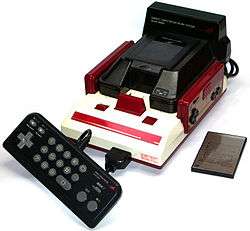Family Computer Network System
|
The Famicom Modem | |
| Developer | Nintendo |
|---|---|
| Type | modem peripheral |
| Generation | Third generation |
| Release date |
|
| Retail availability | 3 years |
| Discontinued |
|
| Units shipped | 130,000[1] |
| Media | ROM card |
| Connectivity | dialup modem |
| Online services | Nomura Securities |
| Related articles | Famicom |
The Family Computer Network System (Japanese: ファミリーコンピュータ ネットワークシステム Hepburn: Famirī Konpyūta Nettowāku Shisutemu), also known as the Famicom Net System or Famicom Modem, is a video game peripheral for Nintendo's Family Computer, released in late 1988 only in Japan. It uses a card based format, reminiscent to the HuCard for Hudson Soft's and NEC's PC Engine or the Sega Card for the Master System.[2][3] It allowed the user access to a server that provided live stock trades, game cheats, jokes, weather forecasts, horse betting, and a small amount of downloadable content.[1]
The experience Nintendo gained with this endeavor led directly to the deployment of the satellite based Satellaview network for the Super Famicom in the early 1990s. Nintendo would eventually engage in Internet based networking, via the 64DD and its accompanying Randnet service, the GameCube, the Game Boy Advance Cable, the Nintendo DS's DS Download Play, the Wii's WiiConnect24 and its shop, the Nintendo DSi's DSi Shop, and the Nintendo Network for the Nintendo 3DS and for the Wii U.
History
Development
Beginning in mid-1987, Nintendo president Hiroshi Yamauchi requested the exploration of a partnership with the Nomura Securities financial company, to create an information network service in Japan based on the Famicom. Led by Masayuki Uemura, Nintendo Research & Development 2 developed the modem hardware; and Nomura Securities developed the client and server software and the information database. Uemura cautioned that they "weren't confident that they would be able to make network games entertaining". Five unreleased prototypes of network-enabled games were developed for the system, including Yamauchi's favorite classic, Go.[1]
Production
The Famicom Modem began mass production in September 1988. The accompanying proprietary online service was soon launched the same year alongside Nippon Telegraph and Telephone's new DDX-TP telephone gateway for its existing packet switched network. NTT's launch initially suffered reliability problems that were painstakingly assessed by Nintendo at individual users' homes and traced back to the network.[1]
Nintendo's sole final application of the Famicom Modem was the 1991 system called Super Mario Club. It was formed for toy shops, where the Famicom was deployed as a networked arcade kiosk, serving consumers with a member-store-created searchable online database of Famicom game reviews. Nintendo performed market research by analyzing users' search behaviors, and directly received user feedback messages.[1]
In June 1989, Nintendo of America's vice president of marketing Peter Main, said that the Famicom was present in 37% of Japan's households and that its interactive game and stock network based upon the Famicom Modem had been running for some time.[4]
Reception
Nintendo shipped a lifetime total of 130,000 Famicom Modems. Even after the resolution of stability problems with the NTT's network launch, the Famicom Modem market presence was considered "weak" for its whole lifetime for various reasons: product usability; competition from personal computers and other appliances; and the difficult nature of early adoption by the technologically unsavvy financial customer. Uemura stated that the system's most popular application was ultimately home-based horse race betting, with a peak of 100,000 units used and capturing 35% of the online horse betting market even amongst diverse competition from PCs and from dedicated horse betting network terminal appliances.[1]
Legacy
Wanting to replicate and expand upon the progress seen with the Famicom Modem in Japan, Nintendo of America began a series of open announcements in mid-1989 to describe its private talks with AT&T over the prospect of launching an information network service in America in 1990.[4] The plans never materialized.
A modem for NES was tested in the United States by the Minnesota State Lottery. It would have allowed players to buy scratchcards and play the lottery with their NES at home. It was not released in the United States because some parents and legislators voiced concern that minors might learn to play the lottery illegally and anonymously, regardless of assurances from Nintendo to the contrary.[5] Internet-based gambling was banned in Minnesota.[6]
Online content would later be delivered to Nintendo's customers via the Super Famicom's Satellaview peripheral. Masayuki Uemura, lead designer of the Famicom Modem at Nintendo Research & Development 2, said: "Our experiences with the Famicom Modem triggered Nintendo’s entrance into the satellite data broadcasting market in April, 1995".[1]
See also
- Atari 2600's GameLine
- Intellivision's PlayCable
- Famicom Disk System
- Sega Genesis's Sega Channel
- XBAND
- Nintendo Entertainment System's Teleplay Modem
- Super Famicom's Satellaview
- 64DD's Japan-based dialup Internet service called Randnet, from December 1999 to February 2001
References
- 1 2 3 4 5 6 7 Takano, Masaharu (September 11, 1995). "How the Famicom Modem was Born". Nikkei Electronics (in Japanese). English translation by GlitterBerri.
- ↑ "ファミコンの周辺機器が大集合! ザ☆周辺機器ズ 11". Ne.jp. Retrieved 2014-06-14.
- ↑ Wi-Fiコネクションについて講演 『ウイイレ』など40タイトルが開発中. Famitsu. 25 March 2006.
- 1 2 Freitag, Michael (June 8, 1989). "Talking Deals; How Nintendo Can Help A.T.&T.". International New York Times. ISSN 0362-4331. Retrieved February 7, 2015.
- ↑ Shapiro, Eben (1991-09-27). "Nintendo and Minnesota Set A Living-Room Lottery Test". New York Times. Retrieved 2008-02-16.
- ↑ "Minnesota Gambling and Criminal Defense". Retrieved February 7, 2015.

